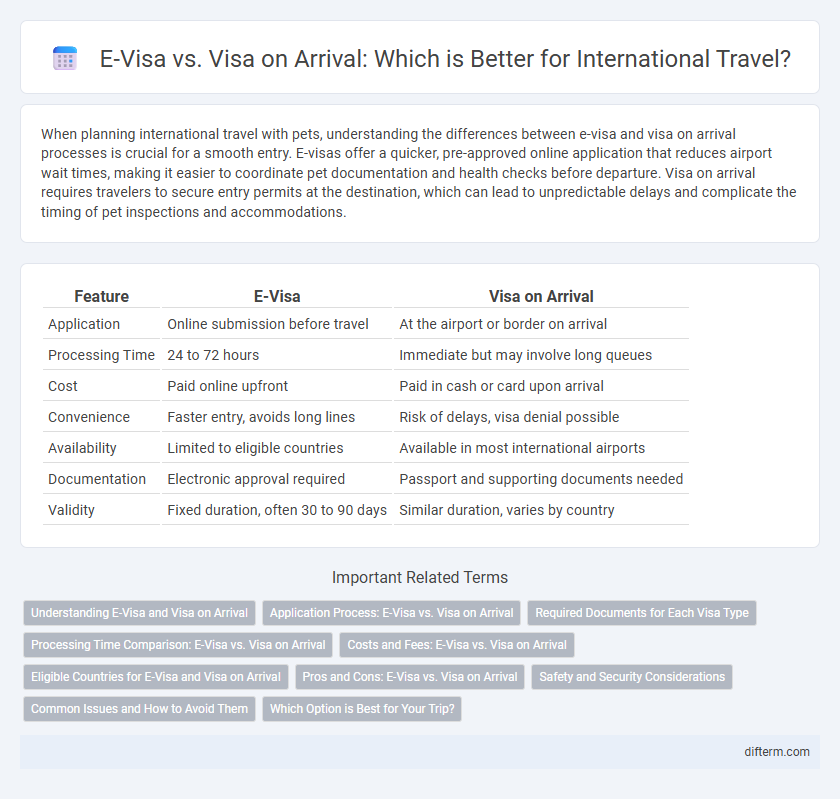When planning international travel with pets, understanding the differences between e-visa and visa on arrival processes is crucial for a smooth entry. E-visas offer a quicker, pre-approved online application that reduces airport wait times, making it easier to coordinate pet documentation and health checks before departure. Visa on arrival requires travelers to secure entry permits at the destination, which can lead to unpredictable delays and complicate the timing of pet inspections and accommodations.
Table of Comparison
| Feature | E-Visa | Visa on Arrival |
|---|---|---|
| Application | Online submission before travel | At the airport or border on arrival |
| Processing Time | 24 to 72 hours | Immediate but may involve long queues |
| Cost | Paid online upfront | Paid in cash or card upon arrival |
| Convenience | Faster entry, avoids long lines | Risk of delays, visa denial possible |
| Availability | Limited to eligible countries | Available in most international airports |
| Documentation | Electronic approval required | Passport and supporting documents needed |
| Validity | Fixed duration, often 30 to 90 days | Similar duration, varies by country |
Understanding E-Visa and Visa on Arrival
E-Visa is an electronically issued travel authorization obtained online before arrival, reducing wait times and simplifying entry requirements. Visa on Arrival allows travelers to obtain a visa at the port of entry, which may involve longer processing times and unpredictable approval. Understanding the differences helps optimize travel planning by selecting the visa option that best suits destination-specific regulations and personal convenience.
Application Process: E-Visa vs. Visa on Arrival
E-visa application requires submitting personal and travel documents online prior to departure, ensuring faster processing and approval before arrival. Visa on arrival involves filling out paperwork and paying fees at the port of entry, which can result in longer wait times and potential delays. E-visas improve trip planning by providing confirmation in advance, while visa on arrival offers more flexibility for spontaneous travelers.
Required Documents for Each Visa Type
E-visa applications typically require a valid passport, recent digital photographs, an online completed application form, and proof of travel arrangements such as flight tickets or hotel bookings. Visa on arrival necessitates presenting a valid passport, passport-sized photos, and often a printed filled-out application form along with payment in cash; some countries may also require a return ticket and proof of accommodation. Understanding these documentation differences helps streamline travel preparation and avoid delays at immigration checkpoints.
Processing Time Comparison: E-Visa vs. Visa on Arrival
E-visa applications typically require 24 to 72 hours for processing, allowing travelers to secure entry authorization before arrival, reducing wait times at immigration. In contrast, visa on arrival processing can take anywhere from 30 minutes to several hours, depending on airport congestion and documentation verification. Choosing an e-visa streamlines entry by minimizing delays, enhancing efficiency compared to the unpredictability of visa on arrival queues.
Costs and Fees: E-Visa vs. Visa on Arrival
E-Visas typically involve an upfront fee that varies by country but often offers a lower overall cost compared to Visa on Arrival, which can include higher fees and unexpected charges at the point of entry. Processing an E-Visa online reduces the need for additional payments at airports, whereas Visa on Arrival requires travelers to pay cash, sometimes in specific currencies, potentially leading to currency exchange losses. Travelers benefit financially by securing an E-Visa in advance, minimizing last-minute expenses and ensuring transparent fee structures.
Eligible Countries for E-Visa and Visa on Arrival
Eligible countries for e-visa programs typically include nations with advanced digital infrastructure and strong bilateral agreements, such as India, Malaysia, and Turkey, facilitating streamlined online applications. Visa on arrival options are commonly offered to travelers from a wider range of countries, especially those with tourism partnerships or regional agreements, including citizens from South East Asian and some African nations. Understanding the specific eligible countries for each visa type is essential for efficient travel planning and avoiding entry complications.
Pros and Cons: E-Visa vs. Visa on Arrival
E-visa offers the advantage of pre-approval, reducing waiting times at immigration and allowing travelers to prepare documents ahead, but it requires online application and payment before the trip. Visa on arrival provides convenience for spontaneous travel without prior application, although it may involve longer queues and uncertainty regarding entry approval at the destination. Both options vary by country policies, and travelers should assess processing fees, eligibility criteria, and travel schedules to determine the most efficient visa method.
Safety and Security Considerations
E-visas enhance safety and security by minimizing physical contact and reducing the risk of fraudulent documents through digital verification systems. Visa on arrival processes often involve crowded checkpoints, increasing potential exposure to health risks and inconsistent security protocols. Governments prioritize e-visa platforms with encrypted data and biometric authentication to ensure traveler identity and streamline border control procedures.
Common Issues and How to Avoid Them
Common issues with e-visas include technical errors during application, document mismatches, and delayed approvals, which can lead to denied entry or travel disruptions. Visa on arrival problems often involve long wait times, insufficient documentation, and unexpected fees, causing inconvenience at the port of entry. To avoid these issues, travelers should apply for e-visas well in advance, carefully follow application instructions, and verify embassy requirements, while preparing all necessary documents and fees upfront for visa on arrival scenarios.
Which Option is Best for Your Trip?
Choosing between an e-visa and a visa on arrival depends on factors like destination, processing time, and convenience. An e-visa allows travelers to apply online in advance, ensuring quicker entry and less hassle upon arrival at airports or borders. Visa on arrival suits spontaneous trips but may involve longer wait times and stricter entry requirements, making e-visas often the optimal choice for planned travel.
e-visa vs visa on arrival Infographic

 difterm.com
difterm.com